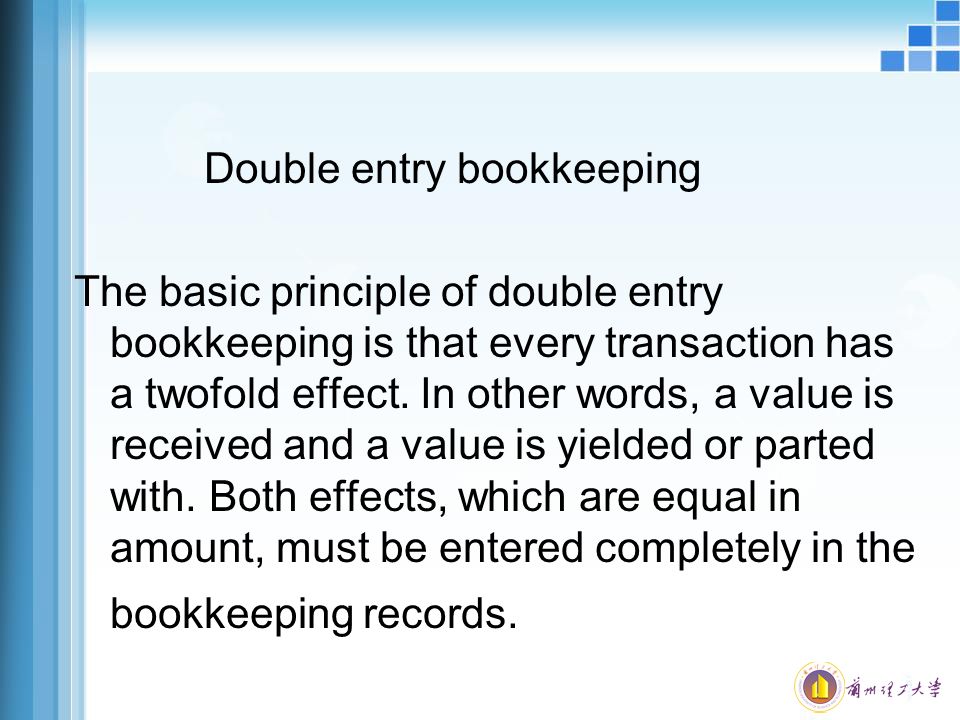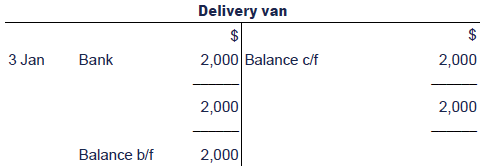Debits And Credits
lso since the ledgers are classified at the time of creation itself, an organization can view all its debtors ledgers at one go. The four basic constraints associated with GAAP include objectivity, materiality, consistency and prudence. Objectivity includes issues such as auditor independence and that information is verifiable. Materiality refers to the completeness of information included in financial reporting and whether information would be valuable to outside parties.
Adjusting Entry

The transaction is recorded as a « debit entry » (Dr) in one account, and a « credit entry » (Cr) in a second account. The debit entry will be recorded on the debit side (left-hand side) of a general ledger account, and the credit entry will be recorded on the credit side (right-hand side) of a general contra asset account ledger account. If the total of the entries on the debit side of one account is greater than the total on the credit side of the same nominal account, that account is said to have a debit balance. We now offer eight Certificates of Achievement for Introductory Accounting and Bookkeeping.
Liabilities
The second general rule of accounting is that transactions are recorded using what is called a « double-entry » accounting method. Originally developed in Italy in the 1400s, double-entry means that for a complete record of a transaction, two entries are made. For example, if you have $5 in http://92.243.4.234/balance-sheet-example/ cash, and want to buy some gasoline for your lawn mower, you take your portable gas can and your money to the gas station and exchange $5 in cash for $5 in gas. This transaction is recorded as an increase in the asset « gas » for $5, and a corresponding reduction in the asset « cash » for $5.
What are basic accounting skills?
The general ledger provides the position of the business at any given point of time. For example an Cash ledger will reflect the cash in hand as on date, the bank ledger will reflect the bank balance.
While this is not required, it is good practice because, at times, account titles may not be enough to describe what actually occurred for a specific transaction. The accountant produces a number of adjustments which make sure that the values comply with accounting principles. These values are then passed through the accounting system resulting in an adjusted trial balance.

Not every software will use the double entry methods, so it is important to check with this with your software provider. If you would like to watch another video about journal entries, click Journal Entries. The statement of cash flows is a listing of the inflows and outflows of cash.
It requires advanced knowledge, which is only possible through rigorous reading and strong experience. It is an accountant’s responsibility to help and navigate their customers through taxation procedures in the most ethical and hassle-free way. An accountant should have an in-depth understanding of various taxes, tax income limits, taxable items, tax rates, etc. However, there are certain jargon, buzzwords and basic accounting skills that are considered as a prerequisite to becoming a successful management accountant.
As it shows in the example above, the balance of a T-account can be figured by first totaling each column. Second, subtract the smaller subtotal from the larger, and finally placing the total in the larger number’s column. For this, it is necessary that the information is accounted for and presented in accordance with its substance and economic reality and not merely with its legal form. An example of this kind of transaction is Vendor/Customer relations. Therefore, it becomes impossible to follow this system by small business concerns.
The world of knowledge is infinite, which means that there is no end to learning, unlearning and relearning new skills that are in sync with the changing times. The same is in the case of accounting, where managerial accountants need to have varied basic accounting skills and need to keep themselves abreast of the new developments in the domain. All in all, the single-entry system makes it harder to get the full picture of your company’s financial standing. Plus, the single-entry system doesn’t require complicated accounting software—a simple spreadsheet or program will do. You could also add a reference column if you’d like to record invoice numbers and a reconciliation column at the far right to tick off if you’ve reconciled (matched) the entry to what’s on your bank statement.
In fine, it can be said that every transaction must possess these characteristics. « Generally Accepted Accounting Principles (GAAP). » Accessed March 11, 2020. Double-entry accounting has been in use for hundreds, if not thousands, of years; it was first documented in a book by Luca Pacioli in Italy in 1494.
The credits for accounts payable are posted daily to subsidiary accounts payable(creditors) , and the monthly total of accounts payable as a credit to accounts payable control. The GST paid debit column is posted as a monthly total to GST paid (a contra-liability account). Trial Balance is a type of accounting report which is used to check the accuracy of the various debit and credit transactions recorded in the ledgers.
- Direct Delivery’s accounting system will show an increase in its account Cash from zero to $20,000, and an increase in its stockholders’ equity account Common Stock by $20,000.
- There are no revenues because no delivery fees were earned by the company, and there were no expenses.
- The first transaction that Joe will record for his company is his personal investment of $20,000 in exchange for 5,000 shares of Direct Delivery’s common stock.
Number Of Entries
There is usually at least one account for every item on a company’s balance sheet and income statement. In theory, there is no limit to the number of accounts that can be created, although the total number of accounts is usually determined by management’s need for information. The Owner’s Equity or Owner’s Capital accounts (for a Proprietorship/Partnership) or the Shareholder’s Equity accounts (for a Corporation) indicate the owner’s equity in the business. As the accounting equation indicates, equity is the difference between the assets of the company, and the company’s debts.
Introduced additional capital ₹10000 in cash and 5000 in goods. Long-term Liabilities are payable after a period of one year. For example, creditors, bills payable, rent normal balance outstanding, bank overdraft, etc. Liabilities are the amounts that an entity owes to the outsiders. These are the obligations or the debts payable by the business.
Instead, Debitoor helps you maintain a constant overview of your income, expenses, and any overdue payments. For each transaction, the total debits recorded must equal the total credits recorded.a.
Credits increase balances in liability accounts, revenue accounts, and capital accounts, and decrease balances in asset accounts and expense accounts. Debits are recorded on the left side of a ledger account, a.k.a. T account. Debits increase balances in asset accounts and expense accounts and decrease balances in liability accounts, revenue accounts, and capital accounts. A journal is a record of transactions listed as they occur that shows the specific accounts affected by the transaction. Used in a double-entry accounting system, journal entries require both a debit and a credit to complete each entry.
This concept calls for an adjustment to be made in respect of prepaid expenses, outstanding expenses, accrued revenue, and unaccrued revenues. Revenue Recognition Principle is mainly concerned with the revenue being recognized in the income statement of an enterprise. An example of this kind of transaction is sales and/or purchases.
Is Accounts Receivable a debit or credit?
The five account types are: Assets, Liabilities, Equity, Revenue (or Income) and Expenses. To fully understand how to post transactions and read financial reports, we must understand these account types.
The certificates include Debits and Credits, Adjusting Entries, Financial Statements, Balance Sheet, Income Statement, Cash Flow Statement, Working Capital and Liquidity, and Payroll Accounting. On December 1, 2019 Joe starts his business Direct Delivery, Inc. The first transaction that Joe will record for his company is his personal investment of $20,000 in exchange for 5,000 shares of Direct Delivery’s common stock. Direct Delivery’s accounting system will show an increase in its account Cash from zero to $20,000, and an increase in its stockholders’ equity account Common Stock by $20,000. There are no revenues because no delivery fees were earned by the company, and there were no expenses.
T-account
For example, if a company pays $20 for a website domain, the cash account will decrease $20 and the advertising expenses account will increase $20. For example, an online bookkeeping e-commerce company buys $1000 worth of inventory on credit. Assets (the inventory account) increase by $1000 and liabilities (accounts payable) increase by $1000.

Sales journal is used for recording the credit sale of merchandise only. Only in the invoice, the trade discount is shown by way of deduction from the invoice price.
Debit And Credit In Accounting
In the double-entry accounting system, at least two accounting entries are required to record each financial transaction. These entries may occur in asset, liability, equity, expense, or revenue accounts. Recording of a debit amount to one or more accounts and an equal credit amount to one or more accounts what is double entry bookkeeping results in total debits being equal to total credits when considering all accounts in the general ledger. If the accounting entries are recorded without error, the aggregate balance of all accounts having Debit balances will be equal to the aggregate balance of all accounts having Credit balances.

